| Maintenance Service Interval | Maintenance Procedure |
|---|---|
| Before each use or daily |
|
Introduction
Important: Use this manual in conjunction with the Polar Trac kit or any other attachments Operator's Manual for additional information on the safe operation and maintenance of your machine and it's attachments.
This traction unit is used in the summer with a rotary-blade lawnmower attachment and in the winter with a snow removal attachment and is intended to be used by professional, hired operators in commercial applications.
Read this information carefully to learn how to operate and maintain your product properly and to avoid injury and product damage. You are responsible for operating the product properly and safely.
You may contact Toro directly at www.Toro.com for product and accessory information, help finding a dealer, or to register your product.
Whenever you need service, genuine Toro parts, or additional information, contact an Authorized Service Dealer or Toro Customer Service and have the model and serial numbers of your product ready. Figure 1 identifies the location of the model and serial numbers on the product. Write the numbers in the space provided.

This manual identifies potential hazards and has safety messages identified by the safety alert symbol (Figure 2), which signals a hazard that may cause serious injury or death if you do not follow the recommended precautions.

This manual also uses 2 words to highlight information. Important calls attention to special mechanical information and Note emphasizes general information worthy of special attention.
Warning
CALIFORNIA
Proposition 65 Warning
Diesel engine exhaust and some of its constituents are known to the State of California to cause cancer, birth defects, and other reproductive harm.
Because in some areas there are local, state, or federal regulations requiring that a spark arrester be used on the engine of this machine, a spark arrester is available as an option. If you require a spark arrester, contact your Authorized Toro Service Dealer.
Genuine Toro spark arresters are approved by the USDA Forestry Service.
Important: It is a violation of California Public Resource Code Section 4442 to use or operate the engine on any forest-covered, brush-covered, or grass-covered land without a spark arrester muffler maintained in working order, or the engine constricted, equipped, and maintained for the prevention of fire. Other states or federal areas may have similar laws.
Safety
These machines meet or exceed ANSI B71.4–2012 specifications in effect at the time of production
Improper use or maintenance by the operator or owner can result in injury. To reduce the potential for injury, comply with these safety instructions and always pay attention to the safety alert symbol, which means Caution, Warning, or Danger—personal safety instruction. Failure to comply with the instruction may result in personal injury or death.
Safe Operating Practices
This product is capable of amputating hands and feet and throwing objects. Always follow all safety instructions to avoid serious injury or death.
Training
-
Read the Operator's Manual and other training material carefully. Be familiar with the controls, safety signs, and the proper use of the equipment.
-
Never allow children or people unfamiliar with these instructions to use the lawn mower. Local regulations can restrict the age of the operator.
-
Never mow while people, especially children, or pets are nearby.
-
Keep in mind that the operator or user is responsible for accidents or hazards occurring to other people or their property.
-
Do not carry passengers.
-
All drivers should seek and obtain professional and practical instruction. Such instruction should emphasize:
-
the need for care and concentration when working with ride-on machines;
-
control of a ride-on machine sliding on a slope will not be regained by the application of the control levers. The main reasons for loss of control are:
-
insufficient wheel grip, especially on wet grass;
-
being driven too fast;
-
inadequate braking;
-
the type of machine is unsuitable for its task;
-
lack of awareness of the effect of ground conditions, especially slopes;
-
incorrect load distribution.
-
-
Preparation
-
While mowing, always wear substantial footwear and long trousers. Do not operate the equipment when barefoot or wearing open sandals.
-
Safety equipment including a hard hat, safety glasses, and hearing protection should be worn.
-
Thoroughly inspect the area where the equipment is to be used and remove all objects which may be thrown by the machine.
-
Check that the operator’s presence controls, safety switches, and shields are attached and functioning properly. Do not operate unless they are functioning properly.
-
Warning—fuel is highly flammable.
-
Store fuel in containers specifically designed for this purpose.
-
Refuel outdoors only and do not smoke while refueling.
-
Add fuel before starting the engine. Never remove the cap of the fuel tank or add fuel while the engine is running or when the engine is hot.
-
If fuel is spilled, do not attempt to start the engine but move the machine away from the area of spillage and avoid creating any source of ignition until fuel vapors have dissipated.
-
Replace all fuel tank and container caps securely.
-
-
Replace faulty silencers/mufflers.
-
Before using, always visually inspect to see that the blades, blade bolts and cutter assembly are not worn or damaged. Replace worn or damaged blades and bolts in sets to preserve balance.
Operation
-
Be alert, slow down and use caution when making turns. Look behind and to the side before changing directions.
-
Do not operate the engine in a confined space where dangerous carbon monoxide fumes can collect.
-
Mow only in daylight or in good artificial light.
-
Before attempting to start the engine, disengage all blade attachment clutches and shift into neutral.
-
Remember there is no such thing as a safe slope. Travel on grass slopes requires particular care. To guard against overturning:
-
do not stop or start suddenly when on a slope;
-
use slow speeds on slopes and during tight turns;
-
stay alert for humps and hollows and other hidden hazards;
-
-
Watch out for traffic when crossing or near roadways.
-
Stop the blades from rotating before crossing surfaces other than grass.
-
When using any attachments, never direct discharge of material toward bystanders nor allow anyone near the machine while in operation.
-
Never operate the machine with damaged guards, shields, or without safety protective devices in place.
-
Do not change the engine governor settings or overspeed the engine. Operating the engine at excessive speed may increase the hazard of personal injury.
-
Before leaving the operator's position:
-
disengage the power take-off and lower the attachments;
-
change into neutral and set the parking brake;
-
stop the engine and remove the key.
-
-
Disengage drive to attachments, stop the engine, and remove the ignition key:
-
before clearing blockages or unclogging chute;
-
before checking, cleaning or working on the lawn mower;
-
after striking a foreign object. Inspect the lawn mower for damage and make repairs before restarting and operating the equipment;
-
if the machine starts to vibrate abnormally (check immediately and make necessary repairs before resuming operation).
-
-
Do not operate the mower under the influence of alcohol or drugs.
-
Lightning can cause severe injury or death. If lightning is seen or thunder is heard in the area, do not operate the machine; seek shelter.
-
Disengage drive to attachments when transporting or not in use.
-
Stop the engine and disengage drive to attachment before refuelling.
Maintenance and Storage
-
Keep all nuts, bolts and screws tight to be sure the equipment is in safe working condition.
-
Never store the equipment with fuel in the tank inside a building where fumes may reach an open flame or spark.
-
Allow the engine to cool before storing in any enclosure.
-
To reduce the fire hazard, keep the engine, silencer/muffler, battery compartment and fuel storage area free of grass, leaves, or excessive grease.
-
Replace worn or damaged parts for safety.
-
If the fuel tank has to be drained, do this outdoors.
-
On multi-bladed mowers, take care as manually rotating one blade can cause other blades to rotate.
-
When machine is to be parked, stored or left unattended, lower the mower deck.
Toro Riding Mower Safety
The following list contains safety information specific to Toro products or other safety information that you must know that is not included in the CEN standard.
-
Engine exhaust contains carbon monoxide, which is an odorless, deadly poison that can kill you. Do not run engine indoors or in an enclosed area.
-
Keep hands, feet, hair and loose clothing away from attachment discharge area, underside of mower and any moving parts while engine is running.
-
Do not touch equipment or attachment parts which may be hot from operation. Allow to cool before attempting to maintain, adjust, or service.
-
Battery acid is poisonous and can cause burns. Avoid contact with skin, eyes and clothing. Protect your face, eyes, and clothing when working with a battery.
-
This machine is not designed or equipped for on-road use and is a “slow-moving vehicle.” If you must cross or travel on a public road, you should be aware of and comply with local regulations, such as required lights, slow moving vehicle signs, and reflectors.
-
Battery gases can explode. Keep cigarettes, sparks and flames away from battery.
-
Use only genuine Toro replacement parts to ensure that original standards are maintained.
-
Use only Toro approved attachments. Warranty may be voided if used with unapproved attachments.
Slope Operation
-
Do not mow near drop-offs, ditches, steep banks or water. Wheels dropping over edges can cause rollovers, which may result in serious injury, death, or drowning.
-
Do not mow slopes when grass is wet. Slippery conditions reduce traction and could cause sliding and loss of control.
-
Do not make sudden turns or rapid speed changes.
-
Use a walk behind mower and/or a hand trimmer near drop-offs, ditches, steep banks or water.
-
Reduce speed and use extreme caution on slopes.
-
Remove or mark obstacles such as rocks, tree limbs, etc. from the mowing area. Tall grass can hide obstacles.
-
Watch for ditches, holes, rocks, dips, and rises that change the operating angle, as rough terrain could overturn the machine.
-
Avoid sudden starts when mowing uphill because the mower may tip backwards.
-
Be aware that loss of traction may occur going downhill. Weight transfer to the front wheels may cause drive wheels to slip and cause loss of braking and steering.
-
Always avoid sudden starting or stopping on a slope. If tires lose traction, disengage the blades and proceed slowly off the slope.
-
Follow the manufacturer's recommendations for wheel weights or counterweights to improve stability.
-
Use extreme care with attachments. These can change the stability of the machine and cause loss of control.
Using the Rollover Protection System (ROPS)
-
Keep the roll bar in the raised and locked position and use the seat belt when operating the machine.
-
Be certain that the seat belt can be released quickly in the event of an emergency.
-
Be aware there is no rollover protection when the roll bar is down.
-
Check the area to be mowed and never fold the ROPS in areas where there are slopes, drop offs or water.
-
Lower the rollbar only when absolutely necessary. Do not wear the seat belt with the roll bar folded down.
-
Check carefully for overhead clearances (i.e. branches, doorways, electrical wires) before driving under any objects and do not contact them.
Engine Emission Certification
The engine in this machine is EPA Tier 4 Final and stage 3b compliant.
Slope Indicator
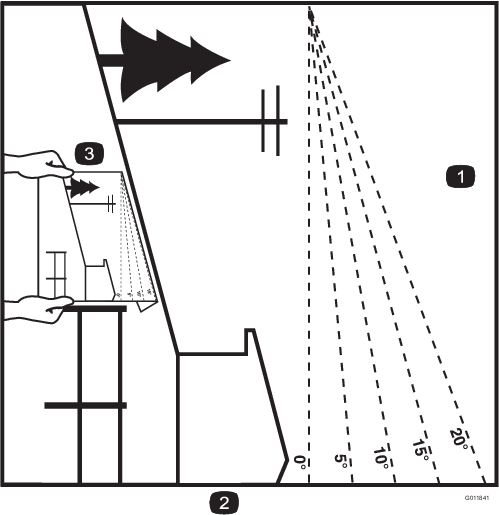
Safety and Instructional Decals
 |
Safety decals and instructions are easily visible to the operator and are located near any area of potential danger. Replace any decal that is damaged or lost. |
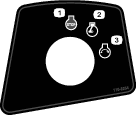

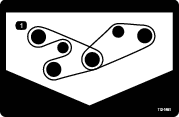
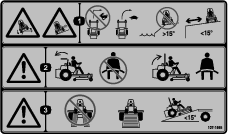



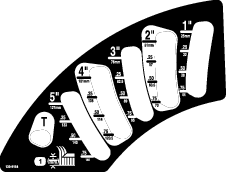
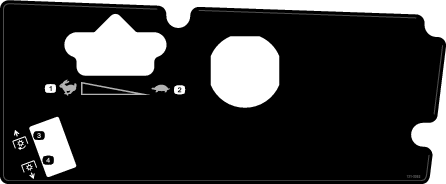
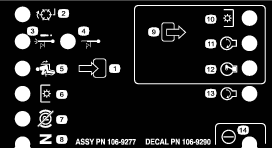

Setup
Checking Fluid Levels
-
Check the hydraulic fluid level before starting the engine, refer to Checking the Hydraulic System.
-
Check the engine oil level before and after starting the engine, refer to Checking the Engine-Oil Level.
-
Check the cooling system before starting the engine; refer to Checking the Cooling System .
Activating and Charging the Battery
Use only electrolyte (1.265 Specific Gravity) to fill battery initially.
-
Remove the battery from the machine.
Important: Do not add electrolyte while the battery is in the machine. You could spill it, causing corrosion.
-
Clean the top of the battery and remove the vent caps (Figure 4).

-
Carefully fill each cell with electrolyte until the plates are covered with about 6 mm (1/4 inch) of fluid (Figure 5).
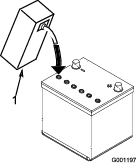
-
Allow approximately 20 to 30 minutes for the electrolyte to soak into the plates.
Warning
Charging the battery produces gasses that can explode, and could cause serious injury or death.
Never smoke near the battery and keep sparks and flames away from battery.
-
Refill as necessary to bring the electrolyte to within about 6 mm (1/4 inch) of the bottom of the fill well (Figure 5).
-
Connect a 3-to-4 amp battery charger to the battery posts. Charge the battery at a rate of 3 to 4 amps until the specific gravity is 1.25 or higher and the temperature is at least 16° C (60° F) with all cells gassing freely.
-
When the battery is charged, disconnect the charger from the electrical outlet and battery posts.
Note: After the battery has been activated, add only distilled water to replace normal loss, although maintenance-free batteries should not require water under normal operating conditions.
Warning
CALIFORNIA
Proposition 65 Warning
Use of this product may cause exposure to chemicals known to the State of California to cause cancer, birth defects, or other reproductive harm.
Warning
Battery terminals or metal tools could short against metal tractor components causing sparks. Sparks can cause the battery gasses to explode, resulting in personal injury.
-
When removing or installing the battery, do not allow the battery terminals to touch any metal parts of the machine.
-
Do not allow metal tools to short between the battery terminals and metal parts of the machine.
-
-
Install the battery into the machine and secure it.
Note: The battery should not move or wiggle when pushed.
-
First, install the positive cable (red) to the positive (+) terminal and then the negative cable (black) to the negative (-) terminal of the battery. Slide the rubber boot over the positive terminal to prevent a possible short from occurring.
Warning
Incorrect battery cable routing could damage the machine and cables causing sparks. Sparks can cause the battery gasses to explode, resulting in personal injury.
-
Always disconnect the negative (black) battery cable before disconnecting the positive (red) cable.
-
Always connect the positive (red) battery cable before connecting the negative (black) cable.
Warning
Connecting cables to the wrong post could damage the electrical system and result in personal injury.
Note: Ensure that the battery cables are routed away from any sharp edges or moving parts.
-
Product Overview
Become familiar with all the controls before you start the engine and operate the machine (Figure 6).
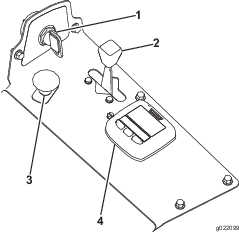
Motion Control Levers
The motion control levers control the forward and rearward motions as well as the turning of the machine. Refer to Driving the Machine.
Parking Brake Lever
Whenever the engine is shut off, engage the parking brake to prevent accidental movement of the machine. To engage the parking brake, pull the parking brake lever rearward and up (Figure 7). To release the parking brake, push the parking brake lever forward and down.

Caution
Do not park the traction unit on a slope.
Ignition Switch
The ignition switch has 3 positions: Off, On/Preheat, and Start.
Throttle Lever
The throttle lever controls the speed of the engine. Moving the throttle lever forward toward the Fast position increases the engine speed. Moving it rearward toward the Slow position decreases the engine speed. The throttle controls the speed of the blades and, in conjunction with motion control levers, controls ground speed of the machine. Always run the machine with the throttle in the Fast position when cutting grass.
Power Take Off (PTO) Switch
The power take-off (PTO) switch starts and stops the mower blades.
Using the InfoCenter LCD Display
The InfoCenter LCD display shows information about your machine such as the operating status, various diagnostics and other information about the machine (Figure 8) There is a splash screen and main information screen of the InfoCenter. You can switch between the splash screen and main information screen, at any time, by pressing any of the InfoCenter buttons and then selecting the appropriate directional arrow.
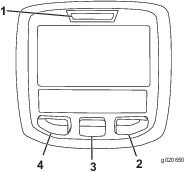
-
Left Button, Menu Access/Back Button—press this button to access the InfoCenter menus. You can use it to back out of any menu you are currently using.
-
Middle Button—use this button to scroll down menus.
-
Right Button—use this button to open a menu where a right arrow indicates additional content.
Note: The purpose of each button may change depending on what is required at the time. Each button will be labeled with an icon displaying its current function.
| SERVICE DUE | Indicates when scheduled service should be performed |
| RPM | Engine rpm/status—indicates the engine rpm |
 | Hour meter |
 | Info icon |
 | Stationary regeneration required |
 | Glow plugs are active |
 | Operator must sit in seat |
 | Parking Brake Indicator—indicates when the parking brake is On |
 | Coolant Temperature-indicates the engine coolant temperature in either °C or °F |
 | Temperature (hot) |
 | Denied or not allowed |
 | Engine Start |
 | Stop or shutdown |
 | Engine |
 | Key switch |
 | PIN code |
 | Hydraulic Oil Temperature-indicates the hydraulic oil temperature |
 | CAN bus |
 | InfoCenter |
 | Bad or failed |
 | Bulb |
 | Output of TEC controller or control wire in harness |
 | High: over allowed range |
 | Low: under allowed range |
 / / | Out of range |
 | Switch |
 | Operator must release switch |
 | Operator should change to indicated state |
| Symbols are often combined to form sentences. Some examples are shown below | |
 | Engine start denied |
 | Engine shutdown |
 | Engine coolant too hot |
 | Sit down or set parking brake |
Using the Menus
To access the InfoCenter menu system, press the menu access button while at the main screen. This brings you to the main menu. Refer to the following tables for a synopsis of the options available from the menus:
| Main Menu | |
| Menu Item | Description |
| Faults | The Faults menu contains a list of the recent machine faults. Refer to the Service Manual or your Authorized Toro Distributor for more information on the Faults menu and the information contained there. |
| Service | The Service menu contains information on the machine such as hours of use and other similar numbers. |
| Settings | The Settings menu allows you to customize and modify configuration variables on the InfoCenter display. |
| About | The About menu lists the model number, serial number, and software version of your machine. |
| Service | |
| Menu Item | Description |
| Hours | Lists the total number of hours that the machine, engine and fan have been on, as well as the number of hours the machine has been transported and has overheated. |
| Settings | |
| Menu Item | Description |
| Units | Controls the units used on the InfoCenter. The menu choices are English or Metric |
| Language | Controls the language used on the InfoCenter*. |
| LCD Backlight | Controls the brightness of the LCD display. |
| LCD Contrast | Controls the contrast of the LCD display. |
| Protected Menus | Allows a person authorized by your company with the PIN code to access protected menus. |
* Only "operator-faced" text is translated. Faults, Service, and Diagnostics screens are "service-faced." Titles will be in the selected language, but menu items are in English.
| About | |
| Menu Item | Description |
| Model | Lists the model number of the machine. |
| SN | Lists the serial number of the machine. |
| Machine Controller Revision | Lists the software revision of the master controller. |
| InfoCenter Revision | Lists the software revision of the InfoCenter. |
| CAN Bus | Lists the machine communication bus status. |
Protected Menus
There is 1 operating configuration setting that is adjustable within the Service Menu of the InfoCenter: Regeneration request—this setting is in the Protected Menu. Refer to Diesel Particulate Filter Regeneration.
Accessing Protected Menus
Note: The factory default PIN code for you machine is either 0000 or 1234.If you changed the PIN code and forgot the code, contact your Authorized Toro Distributor for assistance.
-
From the MAIN MENU, use the center button to scroll down to the SETTINGS MENU and press the right button (Figure 9).

-
In the SETTINGS MENU, use the center button to scroll down to the PROTECTED MENU and press the right button (Figure 10A).
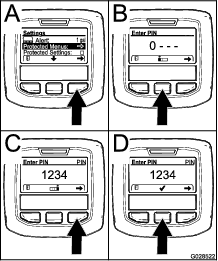
-
To enter the PIN code, press the center button until the correct first digit appears, then press the right button to move on to the next digit (Figure 10B and Figure 10C). Repeat this step until the last digit is entered and press the right button once more.
-
Press the middle button to enter the PIN code (Figure 10D).
Wait until the red indicator light of the InfoCenter illuminates.
Note: If the InfoCenter accepts the PIN code and the protected menu is unlocked, the word “PIN” displays in the upper right corner of the screen.
Note: Rotate the key switch to the OFF position and then to the ON position locks the protected menu.
You have the ability to view and change the settings in the Protected Menu. Once you access the Protected Menu, scroll down to Protect Settings option. Use the right button to change the setting. Setting the Protect Settings to OFF allows you to view and change the settings in the Protected Menu without entering the PIN code. Setting the Protect Settings to ON hides the protected options and requires you to enter the PIN code to change the setting in the Protected Menu. After you set the PIN code, rotate the key switch OFF and back to the ON position to enable and save this feature.
Operation
Note: Determine the left and right sides of the machine from the normal operating position.
Caution
This machine produces sound levels in excess of 85 dBA at the operator’s ear and can cause hearing loss through extended periods of exposure.
Wear hearing protection when operating this machine.
Adding Fuel
Fuel Specification
Important: Use only ultra-low sulphur diesel fuel. Fuel with higher rates of sulfur degrades the diesel oxidation catalyst (DOC), which causes operational problems and shortens the service life of engine components.Failure to observe the following cautions may damage the engine.
-
Never use kerosene or gasoline instead of diesel fuel.
-
Never mix kerosene or used engine oil with the diesel fuel.
-
Never keep fuel in containers with zinc plating on the inside.
-
Do not use fuel additives.
Petroleum Diesel
Cetane rating: 45 or higher
Sulfur content: Ultra-low sulfur (<15 ppm)
| Diesel fuel specification | Location |
| ASTM D975 | USA |
| No. 1-D S15 | |
| No. 2-D S15 | |
| EN 590 | European Union |
| ISO 8217 DMX | International |
| JIS K2204 Grade No. 2 | Japan |
| KSM-2610 | Korea |
-
Use only clean, fresh diesel fuel or biodiesel fuels.
-
Purchase fuel in quantities that can be used within 180 days to ensure fuel freshness.
Use summer-grade diesel fuel (No. 2-D) at temperatures above -7°C (20°F) and winter-grade fuel (No. 1-D or No. 1-D/2-D blend) below that temperature.
Note: Use of winter-grade fuel at lower temperatures provides lower flash point and cold flow characteristics which eases starting and reduces fuel filter plugging.Using summer-grade fuel above -7°C (20°F) contributes toward longer fuel pump life and increased power compared to winter-grade fuel.
Biodiesel
This machine can also use a biodiesel blended fuel of up to B20 (20% biodiesel, 80% petroleum diesel).
Sulfur content: Ultra-low sulfur (<15 ppm)
Biodiesel fuel specification: ASTM D6751 or EN14214
Blended fuel specification: ASTM D975, EN590, or JIS K2204
Important: The petroleum diesel portion must be ultra-low sulfur.
Observe the following precautions:
-
Biodiesel blends may damage painted surfaces.
-
Use B5 (biodiesel content of 5%) or lesser blends in cold weather.
-
Monitor seals, hoses, gaskets in contact with fuel as they may be degraded over time.
-
Fuel filter plugging may be expected for a time after converting to biodiesel blends.
-
Contact your Authorized Toro Distributor if you wish for more information on biodiesel.
Fuel Tank Capacity
43.5 L (11.5 US gallons)
Filling the Fuel Tank
Important: The fuel tanks are connected, but the fuel does not transfer quickly from one tank to the other. It is important when filling that you park on a level surface. If you park on a hill, you may inadvertently overfill the tanks.
Important: Do not overfill the fuel tanks.
Important: Do not open the fuel tanks when parked on a hill. The fuel could spill out.
-
Park the machine on a level surface.
Important: The fuel tanks are connected, but the fuel does not transfer quickly from one tank to the other. It is important when filling that you park on a level surface. If you park on a hill, you may inadvertently overfill the tanks.
-
Shut the engine off and set the parking brake.
-
Clean around each fuel tank cap and remove the cap.
Important: Do not open the fuel tanks when parked on a hill. The fuel could spill out.
-
Add fuel to both fuel tanks, until the level is even with the bottom of the filler neck (Figure 11). Do not over fill the fuel tanks.
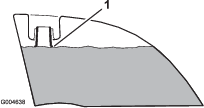
-
Install the fuel tank caps securely. Wipe up any fuel that may have spilled.
Note: If possible, fill the fuel tanks after each use. This will minimize possible buildup of condensation inside the fuel tank.
Checking the Engine-Oil Level
Before you start the engine and use the machine, check the oil level in the engine crankcase; refer to Checking the Engine-Oil Level.
Checking the Cooling System
Before you start the engine and use the machine, check the cooling system; refer to Checking the Cooling System .
Checking the Hydraulic System
Before you start the engine and use the machine, check the hydraulic system; refer to Checking the Hydraulic System.
Think Safety First
Please read all safety instructions and symbols in the safety section. Knowing this information could help you or bystanders avoid injury.
Danger
Operating on wet grass or steep slopes can cause sliding and loss of control.
Wheels dropping over edges can cause rollovers, which may result in serious injury, death or drowning.
There is no rollover protection when the roll bar is down.
Always keep the roll bar in the raised and locked position and use the seat belt.
Read and follow the rollover protection instructions and warnings.
To avoid loss of control and possibility of rollover:
-
Do not operate near drop-offs or near water.
-
Reduce speed and use extreme caution on slopes.
-
Avoid sudden turns or rapid speed changes.

Caution
This machine produces sound levels in excess of 85 dBA at the operators ear and can cause hearing loss through extended periods of exposure.
Wear hearing protection when operating this machine.
The use of protective equipment for eyes, ears, feet and head is recommended.
Operating the Parking Brake
Always set the parking brake when you stop the machine or leave it unattended.
Setting the Parking Brake
-
Move the motion control levers (Figure 17) out to the neutral locked position.
-
Pull up and back on the parking brake lever to set the parking brake (Figure 13).
Note: The parking-brake lever should stay firmly in the engaged position.

Warning
The parking brake may not hold the machine parked on a slope and could cause personal injury or property damage.
Do not park the machine on slopes unless the wheels are chocked or blocked.
Releasing the Parking Brake
Push forward and down on the parking brake lever to release the parking brake (Figure 14).

Starting and Stopping the Engine
Starting the Engine
-
Raise the roll bar up and lock it into place, sit on the seat, and fasten the seat belt.
-
Ensure that the motion controls are in the neutral locked position.
-
Set the parking brake; refer to Setting the Parking Brake.
-
Move the PTO (power take-off) switch to the off position (Figure 15).

-
Turn the ignition key clockwise to the Run position (Figure 16).

-
After the glow plug indicator light dims, turn the key to the Start position. When the engine starts release the key.
Important: Use starting cycles of no more than 15 seconds per minute to avoid overheating the starter motor.
Note: Additional starting cycles may be required when starting the engine for the first time after the fuel system has been completely drained.
Important: When the engine is started for the first time, or after an engine oil change, or an overhaul of the engine, transmission, or wheel motor, operate the machine with the throttle lever in the Slow position in both the forward and reverse directions for 1 to 2 minutes. Also operate the lift lever and PTO lever to ensure proper operation of all parts. Then shut the engine off and check fluid levels, check for oil leaks, loose parts, and any other noticeable malfunctions.
Caution
Shut the engine off and wait for all moving parts to stop before checking for oil leaks, loose parts, or other malfunctions.
Stopping the Engine
-
Disengage the PTO, move the motion control levers to the neutral locked position, set the parking brake, and move the throttle lever to the Slow position.
-
Turn the ignition key to the Off position (Figure 16). Wait for all moving parts to stop before leaving the operating position.
-
Remove the key before transporting or storing machine.
Important: Make sure to remove the key as the fuel pump or accessories may run and cause the battery to lose charge.
Caution
Children or bystanders may be injured if they move or attempt to operate the tractor while it is unattended.
Always remove the ignition key and set the parking brake when leaving the machine unattended, even if just for a few minutes.
Driving the Machine
The throttle control regulates the engine speed as measured in rpm (revolutions per minute). Place the throttle control in the Fast position for best performance. Always operate in the Fast throttle position when mowing.
Caution
The machine can turn very rapidly. You may lose control of it and cause personal injury or damage to machine.
-
Use caution when making turns.
-
Slow the machine down before making sharp turns.
-
Release the parking brake; refer to Releasing the Parking Brake.
Note: The engine will kill if the traction control levers are moved with the parking brake engaged.
-
Move the levers to the center, unlocked position.
-
Drive the machine as follows:
-
To go straight forward, slowly push the motion control levers forward (Figure 17).
-
To go Straight backward, slowly pull the motion control levers rearward (Figure 17).
-
To turn, slow the machine by pulling back on both levers and then push forward on the lever on the opposite side from which you want to turn (Figure 17).
-
To stop, pull the motion control levers to the neutral position.
Note: The farther you move the traction control levers in either direction, the faster the machine will move in that direction.
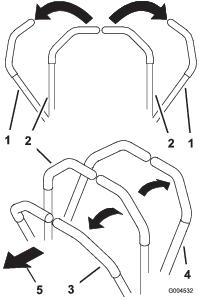
-
Stopping the Machine
To stop the machine, move the traction-control levers to neutral and to the locked position, disengage the power take off (PTO), move the throttle to the Slow position, and stop the engine.
Set the parking brake when you leave the machine; refer to Setting the Parking Brake. Remember to remove the key from the ignition switch.
Caution
Children or bystanders may be injured if they attempt to move or operate the tractor while it is unattended.
Always remove the ignition key and set the parking brake when leaving the machine unattended, even if just for a few minutes.
Cutting Grass with the Machine
Note: Cutting grass at a rate that loads the engine promotes DPF regeneration.
-
Move the machine to the job site.
-
Whenever possible, set the engine-speed switch to high idle.
-
Engage the PTO switch.
-
Gradually move the motion-control levers forward and slowly drive the machine over the mowing area.
-
Once the front of the mower decks are over the mowing area, lower the decks.
-
Cut grass so that the blades can cut and discharge clippings at a high rate while producing a good quality of cut.
Note: If the cutting rate is too high, the quality of cut may deteriorate. Reduce the ground speed of the machine or reduce the width of cut to regain high idle engine speed.
-
When the mower decks are over the far edge of the mowing area, lift the decks.
-
Perform a tear-shaped turn to quickly line up for your next pass.
Diesel Particulate Filter Regeneration
The diesel particulate filter (DPF) is part of the exhaust system. The diesel-oxidation catalyst of the DPF reduces harmful gasses and the soot filter removes soot from the engine exhaust.
The DPF regeneration process uses heat from the engine exhaust to incinerate the soot accumulated on the soot filter, converting the soot to ash, and clears the channels of the soot filter so that filtered engine exhaust flows out the DPF.
The engine computer monitors the accumulation of soot by measuring the back pressure in the DPF. If the back pressure is too high, soot is not incinerating in the soot filter through normal engine operation. To keep the DPF clear of soot, remember the following:
-
Passive regeneration occurs continuously while the engine is running—run the engine at full engine speed when possible to promote DPF regeneration.
-
If the back pressure is too high, the engine computer signals you through the InfoCenter when additional processes (assist and reset regeneration) are running.
-
Allow the assist and reset regeneration process to complete before shutting off the engine.
Operate and maintain your machine with the function of the DPF in mind. Engine load at high idle engine speed generally produce adequate exhaust temperature for DPF regeneration.
Important: Minimize the amount of time that you idle the engine or operate the engine at low-engine speed to help reduce the accumulation of soot in the soot filter.
Caution
The exhaust temperature is hot (approximately 600°C (1112°F) during DPF parked regeneration or recovery regeneration. Hot exhaust gas can harm you or other people.
-
Never operate the engine in an enclosed area.
-
Make sure that there are no flammable materials around the exhaust system.
-
Never touch a hot exhaust system component.
-
Never stand near or around the exhaust pipe of the machine.
DPF Soot Accumulation
-
Over time, the DPF accumulates soot in the soot filter. The computer for the engine monitors the soot level in the DPF.
-
When enough soot accumulates, the computer informs you that it is time to regenerate the diesel particulate filter.
-
DPF regeneration is a process that heats the DPF to convert the soot to ash.
-
In addition to the warning messages, the computer reduces the power produced by the engine at different soot-accumulation levels.
| Indication Level | Fault Code | Engine Power Rating | Recommended Action |
| Level 1: Engine Warning |
 | The computer de-rates the engine power to 85% | Perform a parked regeneration as soon as possible; refer to Parked Regeneration. |
| Level 2: Engine Warning |
 | The computer de-rates the engine power to 50% | Perform a recovery regeneration as soon as possible; refer to Recovery Regeneration. |
DPF Ash Accumulation
-
The lighter ash is discharged through the exhaust system; the heavier ash collects in the soot filter.
-
Ash is a residue of the regeneration process. Over time, the diesel particulate filter accumulates ash that does not discharge with the engine exhaust.
-
The computer for the engine calculates the amount of ash accumulated in the DPF.
-
When enough ash accumulates, the engine computer sends information to the InfoCenter in the form of a system advisory or an engine fault to indicate the accumulation of ash in the DPF.
-
The advisory and faults are indications that it is time to service the DPF.
-
In addition to the warnings, the computer reduces the power produced by the engine at different ash-accumulation levels.
| Indication Level | Advisory or Fault Code | Engine Speed Reduction | Engine Power Rating | Recommended Action |
|---|---|---|---|---|
| Level 1: System Advisory |
 | None | 100% | Notify your service department that advisory #179 displays in the InfoCenter. |
| Level 2: Engine Warning |
 | None | The computer de-rates the engine power to 85% | Service the DPF; refer to Servicing the Diesel-Oxidation Catalyst (DOC) and the Soot Filter |
| Level 3: Engine Warning |
 | None | The computer de-rates the engine power to 50% | Service the DPF; refer to Servicing the Diesel-Oxidation Catalyst (DOC) and the Soot Filter |
| Level 4: Engine Warning |
 | Engine speed at max torque + 200 rpm | The computer de-rates the engine power to 50% | Service the DPF; refer to Servicing the Diesel-Oxidation Catalyst (DOC) and the Soot Filter |
Types of Diesel Particulate Filter Regeneration
| Type of Regeneration | Conditions for DPF regeneration | DPF description of operation |
|---|---|---|
| Passive | Occurs during normal operation of the machine at high-engine speed or high-engine load | The InfoCenter does not display an icon indicating passive regeneration. |
| During passive regeneration, the DPF processes high-heat exhaust gasses; oxidizing harmful emissions and burning soot to ash. | ||
| Refer to Passive DPF Regeneration. | ||
| Assist | Occurs as a result of low-engine speed, low-engine load, or after the computer detects back pressure in the DPF | When the assist/reset-regeneration icon  is displayed in the InfoCenter,
an assist regeneration is in progress. is displayed in the InfoCenter,
an assist regeneration is in progress. |
| During assist regeneration, the computer controls the intake throttle to increase the exhaust temperature, enabling assist regeneration to occur. | ||
| Refer to Assist DPF Regeneration. | ||
| Reset | Occurs after assist regeneration only if the computer detects that assist regeneration did not sufficiently reduce the soot level | When the assist/reset-regeneration icon  is displayed in the InfoCenter,
a regeneration is in progress. is displayed in the InfoCenter,
a regeneration is in progress. |
| Also occurs every 100 hours to reset baseline sensor readings | ||
| During reset regeneration, the computer controls the intake throttle and fuel injectors to increase the exhaust temperature during regeneration. | ||
| Refer to Reset Regeneration. |
| Type of Regeneration | Conditions for DPF regeneration | DPF description of operation |
|---|---|---|
| Parked | Soot buildup occurs as a result of prolonged operation at low-engine speed or low-engine load. May also occur as a result of using incorrect fuel or oil | When the parked-regeneration icon  is displayed in the InfoCenter,
a regeneration is requested. is displayed in the InfoCenter,
a regeneration is requested. |
| The computer detects back pressure due to soot buildup and requests a parked regeneration | ||
| • Perform the parked regeneration as soon as possible to avoid needing a recovery regeneration. | ||
| • A parked regeneration requires 30 to 60 minutes to complete. | ||
| • You must have at least a 1/4 tank of fuel in the tank. | ||
| • You must park the machine to perform a recovery regeneration. | ||
| Refer to Parked Regeneration. | ||
| Recovery | Occurs as a result of ignoring parked regeneration requests and continuing operation, adding more soot when the DPF is already in need of a parked regeneration | When the recovery-regeneration icon  is displayed in the InfoCenter,
a recovery regeneration is requested. is displayed in the InfoCenter,
a recovery regeneration is requested. |
| Contact your Authorized Toro Distributor to have a service technician perform the recovery regeneration. | ||
| • A recovery regeneration requires up to 4 hours to complete. | ||
| • You must have at least a 1/2 tank of fuel in the machine. | ||
| • You must park the machine to perform a recovery regeneration. | ||
| Refer to Recovery Regeneration. |
Passive DPF Regeneration
-
Passive regeneration occurs as part of normal engine operation.
-
While operating the machine, run the engine at full-engine speed when possible to promote DPF regeneration.
Assist DPF Regeneration

-
The assist/reset-regeneration icon displays in the InfoCenter (Figure 24).
-
The computer takes control of the intake throttle to increase the temperature of the engine exhaust.
-
While operating the machine, run the engine at full engine speed when possible to promote DPF regeneration.
-
The
 icon displays in the InfoCenter while the assist
regeneration is processing.
icon displays in the InfoCenter while the assist
regeneration is processing. -
Whenever possible, do not shut off the engine or reduce engine speed while the assist regeneration is processing.
Important: Allow the machine to complete the assist regeneration process before shutting off the engine.
Note: The assist regeneration is finished processing when the
 icon disappears from the
InfoCenter.
icon disappears from the
InfoCenter.
Reset Regeneration

-
The assist/reset-regeneration icon displays in the InfoCenter (Figure 25).
-
The computer takes control of the intake throttle and changes the fuel injection operation to increase the temperature of the engine exhaust.
Important: The assist/reset-regeneration icon indicates that the exhaust temperature discharged from of your machine may be hotter than during regular operation.
-
While operating the machine, run the engine at full engine speed when possible to promote DPF regeneration.
-
The
 icon displays in the InfoCenter while the reset
regeneration is processing.
icon displays in the InfoCenter while the reset
regeneration is processing. -
Whenever possible, do not shut off the engine or reduce engine speed while the reset regeneration is processing.
Important: Allow the machine to complete the reset regeneration process before shutting off the engine.
Note: The reset regeneration is finished processing when the
 icon disappears from the
InfoCenter.
icon disappears from the
InfoCenter.
Parked Regeneration

-
The parked-regeneration requested icon displays in the InfoCenter (Figure 26).
-
If a parked regeneration is needed, the InfoCenter displays engine warning SPN 3719, FMI 16 (Figure 27) and the engine computer derates engine power to 85%.

Important: If you do not complete a parked regeneration within 2 hours, the engine computer derates engine power to 50%.
-
A parked regeneration requires 30 to 60 minutes to complete.
-
If you are authorized by your company, you need the PIN code to perform the parked-regeneration process.
Preparing to Perform a Parked or Recovery Regeneration
-
Ensure that the machine has at least 1/4 tank of fuel.
-
Move the machine outside to an area away from combustible materials.
-
Park the machine on a level surface.
-
Ensure that the traction control or motion-control levers are in the NEUTRAL position.
-
If applicable, lower the cutting units and shut them off.
-
Engage the parking brake.
-
Set the throttle to the low IDLE position.
Performing a Parked Regeneration
Note: For instructions on unlocking protected menus, refer to Accessing Protected Menus.
-
Access the protected menu and unlock the protected settings submenu (Figure 28); refer to Accessing Protected Menus.

-
Navigate to the MAIN MENU, press the center button to scroll down to the SERVICE MENU, and press the right button to select the SERVICE option (Figure 29).
Note: The InfoCenter should display the PIN indicator in the upper right corner of the display.
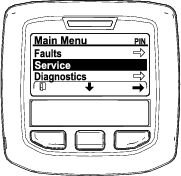
-
In the SERVICE MENU, press the middle button until the DPF REGENERATION options displays, and press the right button to select the DPF REGENERATION option (Figure 30).
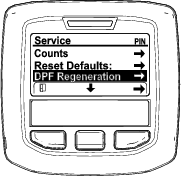
-
When the “Initiate DPF Regen. Are you sure?” message displays, press the center button (Figure 31).
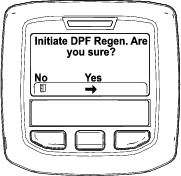
-
If the coolant temperature is below 60°C (140°F) the “Insure
 is running and above 60C/140F” message displays. (Figure 32).
is running and above 60C/140F” message displays. (Figure 32).Observe the temperature in the display, and run the machine at full throttle until the temperature reaches 60°C (140°F), then press the center button.
Note: If the coolant temperature is above 60°C (140°F) this screen is skipped.
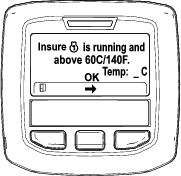
-
Move the throttle control to LOW IDLE and press the center button (Figure 33).

-
The following messages display as the parked regeneration process begins:
-
The “Initiating DPF Regen.” message displays (Figure 34).

-
The “Waiting on
 ” message displays
(Figure 35).
” message displays
(Figure 35).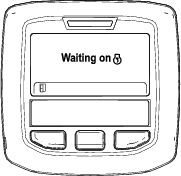
-
The computer determines whether the regeneration runs. One of the following messages displays in the InfoCenter:
-
If the regeneration is allowed, the “Regen Initiated. Allow up to 30 minutes for completion” message displays in the InfoCenter, wait for the machine to complete the parked regeneration process (Figure 36).

-
If the regeneration process is not allowed by the engine computer, the “DPF Regen Not Allowed” message displays in the InfoCenter (Figure 37). Press the left button to exit to the home screen
Important: If you did not meet all the requirements for regeneration or if less than 50 hours have passed since the last regeneration, the “DPF Regen Not Allowed” message appears.
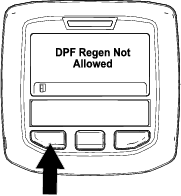
-
-
-
While the regeneration is running, the InfoCenter returns to the home screen and shows the following icons:

The engine is cold—wait. 
The engine is warm—wait. 
The engine hot—regeneration in progress (percent complete). -
The parked regeneration is complete when the “Regen Complete” message displays in the InfoCenter. Press the left button to exit to the home screen (Figure 38).
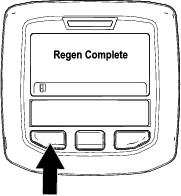
Recovery Regeneration
-
If you ignore the request for a parked regeneration (displayed in the InfoCenter) and continue to operate the machine, a critical amount of soot builds up in the DPF.
-
If a recovery regeneration is needed, the InfoCenter displays engine warning SPN 3719, FMI 16 (Figure 39) and the engine computer derates engine power to 85%.

Important: If you do not complete a recovery regeneration within 15 minutes, the engine computer derates engine power to 50%.
-
Perform a recovery-regeneration whenever there is a loss of engine power and a parked regeneration cannot effectively clean the DPF of soot.
-
A recovery regeneration requires up to 4 hours to complete.
-
You need a distributor technician to perform the recovery regeneration process; contact your Authorized Toro Distributor.
The Safety Interlock System
Caution
If the safety interlock switches are disconnected or damaged the machine could operate unexpectedly causing personal injury.
-
Do not tamper with the interlock switches.
-
Check the operation of the interlock switches daily and replace any damaged switches before operating the machine.
Understanding the Safety Interlock System
The safety interlock system is designed to prevent the engine from starting unless:
-
You are sitting on the seat or the parking brake is engaged.
-
The power take-off (PTO) is disengaged.
-
The motion-control levers are in the neutral locked position
-
The engine temperature is below the maximum operating temperature.
The safety interlock system also is designed to stop the engine when the traction controls are moved from the neutral locked position with the parking brake engaged. If you rise from the seat when the PTO is engaged there is a 1-second delay and then the engine stops.
Testing the Safety Interlock System
Test the safety interlock system before you use the machine each time. If the safety system does not operate as described below, have an Authorized Service Dealer repair the safety system immediately.
-
Sitting on the seat, engage the parking brake and move the PTO to on. Try starting the engine; the engine should not crank.
-
Sitting on the seat, engage the parking brake and move the PTO to off. Move either motion control lever (out of neutral locked position). Try starting the engine; the engine should not crank. Repeat for other control lever.
-
Sitting on the seat, engage the parking brake, move the PTO switch to off and move the motion control levers to the neutral locked position. Now start the engine. While the engine is running, release the parking brake, engage the PTO and rise slightly from the seat; the engine should stop within 2 seconds.
-
Without an operator on the seat, engage the parking brake, move the PTO switch to off and move the motion control levers to the neutral locked position. Now start the engine. While the engine is running, center either motion control; the engine should stop within 2 seconds. Repeat for the other motion control.
-
Without an operator on the seat, disengage the parking brake, move the PTO switch to off, and move the motion control levers to the neutral locked position. Try starting the engine; the engine should not crank.
Using the SCM to Diagnose System Problems
The machine is equipped with a standard control module (SCM) monitoring system that tracks the function of various key systems. The SCM is located under the right control panel. Access it through the side panel cover (Figure 40). To open the side panel cover, release the 2 latches and pull out on it.
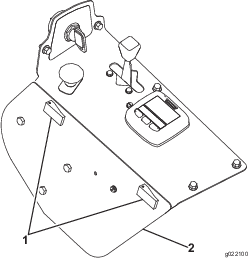
On the face of the SCM are 11 LEDs that illuminate to indicate various system conditions. Seven of these lights can be used by the operator for system diagnosis. Refer to Figure 41 for a description of what each light means. For details on using the rest of the SCM functions, refer to the Service Manual, available through your Authorized Toro Distributor.
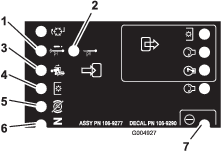
Unlatching the Seat
To access the hydraulic and other systems under the seat, unlatch the seat and swing it forward.
-
Use the seat position adjustment lever to slide the seat all the way forward.
-
Pull the seat latch forward and lift up to unlatch the seat (Figure 42).
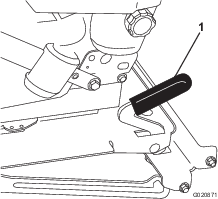
Positioning the Seat
Changing the Seat Position
The seat can move forward and backward. Position the seat where you have the best control of the machine and are most comfortable.
-
To adjust, move the lever sideways to unlock the seat (Figure 43).
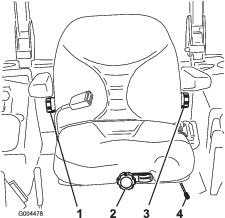
-
Slide the seat to the desired position and release lever to lock in position.
-
Verify that the seat has locked into place by attempting to move it back and forth.
Changing the Seat Suspension
The seat can be adjusted to provide a smooth and comfortable ride. Position the seat where you are most comfortable.
Without sitting on the seat, turn the knob in front either direction to provide the best comfort (Figure 43).
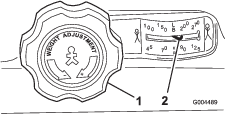
Changing the Back Position
The back of the seat can be adjusted to provide a comfortable ride. Position the back of the seat where it is most comfortable.
To adjust it, turn the knob, under the right-side arm rest, in either direction to provide the best comfort (Figure 43).
Changing the Lumbar Support
The back of the seat can be adjusted to provide a customized lumbar support for your lower back.
To adjust it, turn the knob, under the left-side arm rest, in either direction to provide the best comfort (Figure 43).
Pushing the Machine by Hand
Important: Never tow the machine because hydraulic damage may occur.
Pushing the Machine
-
Disengage the power take-off (PTO) and turn the ignition key to off. Move the levers to the neutral locked position and apply the parking brake. Remove the key.
-
Lift the seat.
-
Rotate each by-pass valve counterclockwise 1 turn (Figure 45).
This allows hydraulic fluid to by-pass the pump enabling the wheels to turn.
Important: Do not rotate the by-pass valves more than 1 turn. This prevents valves from coming out of the body and causing fluid to run out.
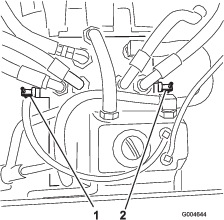
-
Disengage the parking brake before pushing.
Changing to Machine Operation
Rotate each by-pass valve clockwise 1 turn and hand tighten them (torque of approximately 8 N-m (71 in-lb) (Figure 45).
Note: Do not over tighten the by-pass valves.
The machine will not drive unless the by-pass valves are turned inward.
Loading Machines
Use extreme caution when loading units on trailers or trucks. One full-width ramp that is wide enough to extend beyond the rear tires is recommended instead of individual ramps for each side of the unit (Figure 46). The lower rear section of the tractor frame extends back between the rear wheels and serves as a stop for tipping backward. Having a full-width ramp provides a surface for the frame members to contact if the unit starts to tip backward. If it is not possible to use one full-width ramp, use enough individual ramps to simulate a full-width continuous ramp.
The ramp should be long enough so that the angles do not exceed 15 degrees (Figure 46). A steeper angle may cause mower components to get caught as the unit moves from ramp to trailer or truck. Steeper angles may also cause the unit to tip backward. If loading on or near a slope, position the trailer or truck so it is on the down side of the slope and the ramp extends up the slope. This will minimize the ramp angle. The trailer or truck should be as level as possible.
Important: Do not attempt to turn the unit while on the ramp; you may lose control and drive off the side.
Avoid sudden acceleration when driving up a ramp and sudden deceleration when backing down a ramp. Both maneuvers can cause the unit to tip backward.
Warning
Loading a unit onto a trailer or truck increases the possibility of backward tip-over and could cause serious injury or death.
-
Use extreme caution when operating a unit on a ramp.
-
Use only a single, full-width ramp; Do not use individual ramps for each side of the unit.
-
If individual ramps must be used, use enough ramps to create an unbroken ramp surface wider than the unit.
-
Do not exceed a 15 degree angle between ramp and ground or between ramp and trailer or truck.
-
Avoid sudden acceleration while driving unit up a ramp to avoid tipping backward.
-
Avoid sudden deceleration while backing unit down a ramp to avoid tipping backward.

Transporting Machines
Warning
Driving on the street or roadway without turn signals, lights, reflective markings, or a slow moving vehicle emblem is dangerous and can lead to accidents causing personal injury.
Do not drive machine on a public street or roadway without signs, lights, and/or markings required by local regulations.
Use a heavy-duty trailer or truck to transport the machine. Ensure that the trailer or truck has all necessary lighting and marking as required by law. Please carefully read all the safety instructions. Knowing this information could help you or bystanders avoid injury.
To transport the machine:
-
Ensure that your vehicle, hitch, safety chains, and trailer are adequate for the load you are pulling and that they meet all local traffic regulations for your area.
-
Lock the brake and block the wheels.
-
Securely fasten the machine to the trailer or truck with straps, chains, cable, or ropes as required by local traffic regulations in your area (Figure 47).
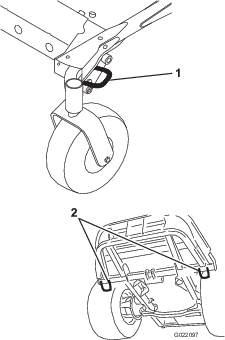
Maintenance
Note: Determine the left and right sides of the machine from the normal operating position.
Note: Looking for an Electrical Schematic or Hydraulic Schematic for your machine? Download a free copy of the schematic by visiting www.Toro.com and searching for your machine from the Manuals link on the home page.
Recommended Maintenance Schedule(s)
| Maintenance Service Interval | Maintenance Procedure |
|---|---|
| After the first 200 hours |
|
| Before each use or daily |
|
| Every 50 hours |
|
| Every 100 hours |
|
| Every 200 hours |
|
| Every 250 hours |
|
| Every 400 hours |
|
| Every 800 hours |
|
| Every 1,500 hours |
|
| Every 6,000 hours |
|
| Every 2 years |
|
Important: Refer to your Engine Operator's Manual for additional maintenance procedures. A detailed Service Manual is also available for purchase from your Authorized Toro Distributor.
Pre-Maintenance Procedures
Important: The fasteners on the covers of this machine are designed to remain on the cover after removal. Loosen all of the fasteners on each cover a few turns so that the cover is loose but still attached, then go back and loosen them until the cover comes free. This will prevent you from accidentally stripping the bolts free of the retainers.
Lubrication
Greasing the Bearings and Bushings
| Maintenance Service Interval | Maintenance Procedure |
|---|---|
| Every 50 hours |
|
The machine has grease fittings that must be lubricated regularly with No. 2 general-purpose, lithium-based grease. If the machine is operated under normal conditions, lubricate all bearings and bushings after every 50 hours of operation. Lubricating bearings and bushings daily when operating conditions are extremely dusty and dirty. Dusty and dirty operating conditions could cause dirt to get into the bearings and bushings, resulting in accelerated wear. Lubricate the grease fittings immediately after every washing, regardless of interval specified.
-
Wipe the grease fittings clean so that foreign matter cannot be forced into the bearing or bushing.
-
Pump grease into the fittings.
-
Wipe off excess grease.
Note: Bearing life can be negatively affected by improper wash down procedures. Do not wash down the unit when it is still hot and avoid directing high-pressure or high volume spray at the bearings or seals.
Engine Maintenance
Checking the Air Cleaner
-
Check the air cleaner body for damage, which could possibly cause an air leak. Replace a damaged air cleaner body. Check the whole clean air intake system for leaks, damage, or loose hose clamps.
-
Service the air cleaner filter when the air cleaner indicator (Figure 49) shows red or every 400 hours (more frequently in extremely dusty or dirty conditions). Do not over service the air filter.
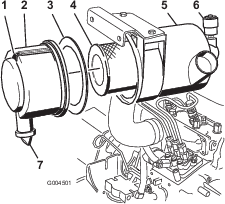
-
Be sure the cover is seated correctly and seals with the air cleaner body.
Servicing the Air Cleaner
| Maintenance Service Interval | Maintenance Procedure |
|---|---|
| Every 400 hours |
|
-
Pull the latch outward and rotate the air-cleaner cover counter-clockwise (Figure 49).
-
Remove the cover from the air-cleaner body (Figure 49).
-
Before removing the filter, use low pressure air (40 psi, clean and dry) to help remove large accumulations of debris packed between outside of primary filter and the canister.
This cleaning process prevents debris from migrating into the intake when the primary filter is removed.
Important: Avoid using high-pressure air which could force dirt through the filter into the intake tract.
-
Remove and replace the primary filter (Figure 49).
Important: Do not clean the used element to avoid damage to the filter media.
-
Inspect the new filter for shipping damage, checking the sealing end of the filter and the body.
Important: Do not use a damaged element.
-
Ensure that the foam gasket is in place in the cover and that it is not torn or damaged (Figure 49).
Note: If it is damaged, replace it.
-
Insert the new filter by applying pressure to the outer rim of the element to seat it in the canister.
Important: Do not apply pressure to the flexible center of the filter.
-
Clean the dirt ejection port (located in the removable cover) as follows:
-
Remove the rubber outlet valve from the cover (Figure 49).
-
Clean the cavity.
-
Replace the outlet valve.
-
-
Install the cover orienting the rubber outlet valve in a downward position—between approximately 5:00 to 7:00 when viewed from the end.
-
Reset the indicator (Figure 49) if showing red.
Servicing the Engine Oil
Oil Specification
Use high-quality, low-ash engine oil that meets or exceeds the following specifications:
-
API service category CJ-4 or higher
-
ACEA service category E6
-
JASO service category DH-2
Important: Using engine oil other than API CJ-4 or higher, ACEA E6, or JASO DH-2 may cause the diesel particulate filter to plug or cause engine damage.
Use the following engine oil viscosity grade:
-
Preferred oil: SAE 15W-40 (above 0°F)
-
Alternate oil: SAE 10W-30 or 5W-30 (all temperatures)
Toro Premium Engine Oil is available from your Authorized Toro Distributor in either 15W-40 or 10W-30 viscosity grades. See the parts catalog for part numbers.
Checking the Engine-Oil Level
| Maintenance Service Interval | Maintenance Procedure |
|---|---|
| Before each use or daily |
|
The engine is shipped with oil in the crankcase; however, the oil level must be checked before and after the engine is first started.
Important: Check the engine oil daily. If the engine-oil level is above the Full mark on the dipstick, the engine oil may be diluted with fuel;If the engine oil level is above the Full mark, change the engine oil.
The best time to check the engine oil is when the engine is cool before it has been started for the day. If it has already been run, allow the oil to drain back down to the sump for at least 10 minutes before checking. If the oil level is at or below the Add mark on the dipstick, add oil to bring the oil level to the Full mark. Do not overfill the engine with oil.
Important: Keep the engine oil level between the upper and lower limits on the dipstick; the engine may fail if you run it with too much or too little oil.
-
Park the machine on a level surface. Unlock the engine cover latches.
-
Open the engine cover.
-
Remove the dipstick, wipe it clean, install the dipstick into the tube, and pull it out again. The oil level should be between the full and add marks (Figure 50).
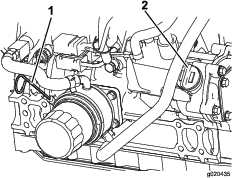
-
If the oil level is low, remove the fill cap (Figure 50) and add oil until it is between the full and add marks. Do not overfill.
-
Install the oil fill cap and dipstick.
-
Close the engine cover and secure it with the latches.
Crankcase Oil Capacity
5.2 liters (5.5 qt) with the filter.
Changing the Engine Oil And Filter
| Maintenance Service Interval | Maintenance Procedure |
|---|---|
| Every 250 hours |
|
Change the oil and filter every 250 hours.
-
Remove the engine oil drain plug (Figure 51) and let the oil flow into a drain pan. When all the oil is drained, install the drain plug.
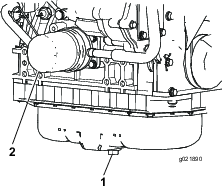
-
Remove the oil filter (Figure 51). Apply a light coat of clean oil to the new filter seal before screwing it on. Do not overtighten.
-
Add oil to the crankcase; refer to Checking the Engine Oil.
Servicing the Diesel-Oxidation Catalyst (DOC) and the Soot Filter
| Maintenance Service Interval | Maintenance Procedure |
|---|---|
| Every 6,000 hours |
|
-
If advisory message displays in the InfoCenter, the DPF is nearing the recommended point for servicing the diesel-oxidation catalyst and the soot filter.

-
If engine faults , , or in the InfoCenter (Figure 53) display in the InfoCenter, clean the soot filter using the steps that follow:



-
Refer to the Engine section in the Service Manual for information on disassembling and assembling the diesel-oxidation catalyst and the soot filter of the DPF.
-
Refer to your Authorized Toro Distributor for diesel-oxidation catalyst and the soot filter replacement parts or service.
-
Contact your Authorized Toro Distributor to have them reset the engine ECU after you install a clean DPF.
-
Fuel System Maintenance
Note: Refer to Fuel Specification for proper fuel recommendations.
Danger
Under certain conditions, diesel fuel and fuel vapors are highly flammable and explosive. A fire or explosion from fuel can burn you and others and can cause property damage.
-
Use a funnel and fill the fuel tank outdoors, in an open area, when the engine is off and is cold. Wipe up any fuel that spills.
-
Do not fill the fuel tank completely full. Add fuel to the fuel tank until the level is to the bottom of the filler neck.
-
Never smoke when handling fuel, and stay away from an open flame or where fuel fumes may be ignited by a spark.
-
Store fuel in a clean, safety-approved container and keep the cap in place.
Servicing the Water Separator
| Maintenance Service Interval | Maintenance Procedure |
|---|---|
| Every 400 hours |
|
Drain water or other contaminants from water separator (Figure 54) daily.
-
Place a clean container under the fuel filter.
-
Loosen the drain plug on the bottom of the filter canister and open the vent on the top of the canister mount.

-
Clean the area where the filter canister mounts.
-
Remove the filter canister and clean the mounting surface.
-
Lubricate the gasket on the filter canister with clean oil.
-
Install the filter canister by hand until the gasket contacts mounting surface, then rotate it an additional 1/2 turn.
-
Tighten the drain plug on the bottom of the filter canister and close the vent on the top of the canister mount.
Servicing the Engine Fuel Filter
| Maintenance Service Interval | Maintenance Procedure |
|---|---|
| Every 400 hours |
|
The engine fuel filter should be replaced after every 400 hours of operation.
-
Clean the area around the fuel filter head (Figure 55).
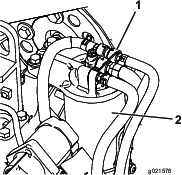
-
Remove the filter and clean the filter head mounting surface (Figure 55).
-
Lubricate the filter gasket with clean lubricating engine oil. Refer to the Engine Operator's Manual, included with the machine, for additional information.
-
Install the dry filter canister, by hand, until the gasket contacts the filter head, then rotate it an additional 1/2 turn.
-
Start the engine and check for fuel leaks around the filter head.
Cleaning the Fuel Tank
| Maintenance Service Interval | Maintenance Procedure |
|---|---|
| Every 2 years |
|
Drain and clean fuel tank every 2 years. Also, remove and clean the in-line strainers after draining the tank. Use clean diesel fuel to flush out the tank.
Important: Drain and clean the tank if the fuel system becomes contaminated or if the machine is to be stored for an extended period.
Fuel Lines and Connections
| Maintenance Service Interval | Maintenance Procedure |
|---|---|
| Every 400 hours |
|
Check the fuel lines and connections. Inspect them for deterioration, damage, chaffing, or loose connections.
Electrical System Maintenance
Important: Whenever working with the electrical system, always disconnect the battery cables, negative (-) cable first, to prevent possible wiring damage from short-outs.
Servicing the Battery
| Maintenance Service Interval | Maintenance Procedure |
|---|---|
| Every 50 hours |
|
Warning
Battery posts, terminals, and related accessories contain lead and lead compounds, chemicals known to the State of California to cause cancer and reproductive harm. Wash hands after handling.
Keep the top of the battery clean. If you store the machine in a location where temperatures are extremely high, the battery will run down more rapidly than if the machine is stored in a location where the temperature is cool.
Keep the top of the battery clean by washing it periodically with a brush dipped in ammonia or bicarbonate of soda solution. Flush the top surface with water after cleaning it. Do not remove the fill caps while cleaning the battery.
The battery cables must be tight on the terminals to provide good electrical contact.
If corrosion occurs at the terminals, disconnect the cables, negative (-) cable first, and scrape the clamps and terminals separately. Connect the cables, positive (+) cable first, and coat the terminals with petroleum jelly.
Warning
Battery terminals or metal tools could short against metal machine components causing sparks. Sparks can cause the battery gasses to explode, resulting in personal injury.
-
When removing or installing the battery, do not allow the battery terminals to touch any metal parts of the machine.
-
Do not allow metal tools to short between the battery terminals and metal parts of the machine.
Warning
Incorrect battery cable routing could damage the machine and cables causing sparks. Sparks can cause the battery gasses to explode, resulting in personal injury.
-
Always disconnect the negative (black) battery cable before disconnecting the positive (red) cable.
-
Always connect the positive (red) battery cable before connecting the negative (black) cable.
Storing the Battery
If the machine will be stored more than 30 days, remove the battery and charge it fully. Either store it on a shelf or on the machine. Leave the cables disconnected if it is stored on the machine. Store the battery in a cool environment to prevent the battery from discharging rapidly. To prevent the battery from freezing, make sure it is fully charged. The specific gravity of a fully charged battery is 1.265 to 1.299.
Checking the Fuses
The fuses are located under the control panel. Access them through the side panel cover (Figure 56). To open the side panel cover, release the 2 latches and pull out on it.
If the machine stops or has other electrical system issues, check the fuses. Grasp each fuse in turn and remove them one at a time, checking to see if any are blown. If you need to replace a fuse, always use the same type and amperage rated fuse as the one you are replacing, otherwise you could damage the electrical system (refer to the decal next to the fuses (Figure 57) for a diagram of each fuse and its amperage).
Note: If a fuse blows frequently, you probably have a short in the electrical system and should have it serviced by a qualified service technician.


Cooling System Maintenance
Danger
Discharging hot pressurized coolant or touching hot radiator and surrounding parts can cause severe burns.
-
Do not remove the radiator cap when the engine is hot. Always allow the engine to cool at least 15 minutes or until the radiator cap is cool enough to touch without burning your hand before removing the radiator cap.
-
Do not touch radiator and surrounding parts that are hot.
Danger
The rotating fan and drive belt can cause personal injury.
-
Do not operate the machine without the covers in place.
-
Keep fingers, hands and clothing clear of rotating fan and drive belt.
-
Shut off the engine and remove the ignition key before performing maintenance.
Caution
Swallowing engine coolant can cause poisoning.
-
Do not swallow engine coolant.
-
Keep out of reach from children and pets.
Checking the Cooling System
| Maintenance Service Interval | Maintenance Procedure |
|---|---|
| Before each use or daily |
|
The cooling system is filled with a 50/50 solution of water and permanent ethylene glycol anti freeze. Check the level of the coolant in the expansion tank at the beginning of each day before starting the engine. The capacity of the cooling system is 7.5 liters (6 quarts).
-
Check the level of the coolant in the expansion tank (Figure 58). The coolant level should be between the marks on the side of the tank.
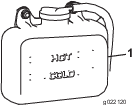
-
If coolant level is low, remove the expansion tank cap and replenish the system. Do not overfill.
-
Install the expansion tank cap.
Cleaning the Radiator
| Maintenance Service Interval | Maintenance Procedure |
|---|---|
| Before each use or daily |
|
| Every 200 hours |
|
| Every 1,500 hours |
|
| Every 2 years |
|
To prevent the engine from overheating, the radiator must be kept clean. Normally, check the radiator daily and, if necessary, clean any debris off these parts. However, it will be necessary to check and clean the radiator frequently in extremely dusty and dirty conditions.
Note: If the mower deck or engine shuts off due to overheating, first check the radiator for excessive buildup of debris.
Clean the radiator as follows:
-
Open the hood.
-
Working from the fan side of the radiator, blow out debris with low pressure (50 psi) compressed air (do not use water). Repeat the step from the front of the radiator and again from the fan side.
-
After the radiator is thoroughly cleaned, clean out debris that may have collected in the channel at the radiator base.
-
Close the hood.
Brake Maintenance
Adjusting the Parking Brake Interlock Switch
-
Stop the machine, move the deck lift switch fully into the neutral-locked position, set the parking brake, and remove the ignition key.
-
Remove the bolts securing the front panel and remove the panel (Figure 59).
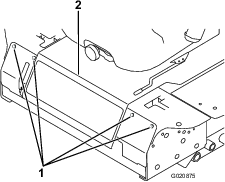
-
Loosen the 2 jam nuts securing the parking brake interlock switch to the mounting bracket.
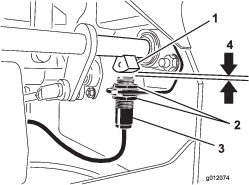
-
Move the switch up or down on the bracket until the distance between the brake shaft sensor and the switch plunger is 3.9 mm (5/32 inch) (Figure 60).
Note: Make sure that the brake-shaft sensor does not contact the switch plunger.
-
Secure the switch jam nuts.
-
Test the adjustment as follows:
-
Ensure that the parking brake is engaged and you are not sitting on the seat, then start the engine.
-
Move the control levers out of the neutral locked position.
The engine should stop. If not, recheck the adjustment you made to the switch.
-
-
Install the front panel.
Belt Maintenance
Checking the Alternator Belt
| Maintenance Service Interval | Maintenance Procedure |
|---|---|
| Every 100 hours |
|
Check the condition and tension of the belts (Figure 61) after every 100 operating hours.
-
Proper tension will allow 10 mm (3/8 inch) deflection when a force of 44 N (10 lb.) is applied on the belt midway between the pulleys.
-
If the deflection is not 10 mm (3/8 inch), loosen the alternator mounting bolts (Figure 61). Increase or decrease the alternator belt tension and tighten the bolts. Check the deflection of the belt again to ensure that the tension is correct.
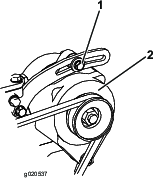
Controls System Maintenance
Adjusting the Control Lever Neutral Interlock Switch
-
Stop the machine, move the deck lift switch fully into the neutral-locked position, set the parking brake, and remove the ignition key.
-
Remove the bolts securing the front panel and remove the panel (Figure 62).

-
Loosen the 2 screws securing the interlock switch (Figure 63).
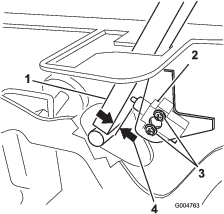
-
Holding the control lever against the frame, move the switch toward the lever until the distance between lever and switch body is 0.4 to 1 mm (0.015 to 0.045 inch ) (Figure 63).
-
Secure the switch.
-
Repeat steps 3 to 5 for the other lever.
-
Install the front panel.
Adjusting the Control Lever Neutral Return
If the motion control levers do not align with the neutral slots when released from the reverse drive position, adjustment is required. Adjust each lever, spring, and rod separately.
-
Disengage the PTO, move the control lever to the neutral locked position, and set the parking brake.
-
Move the throttle lever to the Slow position, stop the engine, remove the key, and wait for all moving parts to stop before leaving the operating position.
-
Remove the bolts securing the front panel and remove the panel (Figure 64).

-
Move the control lever to the neutral position but not locked (Figure 66).
-
Pull the lever back until the clevis pin (on an arm above the pivot shaft) contacts the end of the slot (just beginning to put pressure on the spring) (Figure 65).
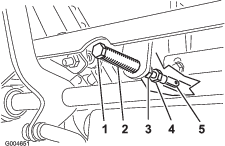
-
Check where the control lever is relative to notch in console (Figure 66).
Note: It should be centered allowing lever to pivot outward to the neutral lock position.

-
If adjustment is needed, loosen the nut and jam nut against the yoke (Figure 65).
-
Applying slight rearward pressure on the motion control lever, turn the head of the adjustment bolt in the appropriate direction until the control lever is centered in the neutral lock position (Figure 65).
Note: Keeping rearward pressure on the lever will keep the pin at the end of the slot and allow the adjustment bolt to move the lever to the appropriate position.
-
Tighten the nut and jam nut (Figure 65).
-
Repeat steps 4 through 9 for the other control lever.
-
Install the front panel.
Adjusting the Traction Drive for Neutral
This adjustment must be made with drive wheels turning.
Danger
Mechanical or hydraulic jacks may fail to support the machine and cause a serious injury.
-
Use jack stands when supporting the machine.
-
Do not use hydraulic jacks.
Warning
The engine must be running to perform this adjustment. Contact with moving parts or hot surfaces may cause personal injury.
Keep hands, feet, face, clothing, and other body parts away from rotating parts, muffler, and other hot surfaces.
-
Raise the frame onto stable jack stands so that the drive wheels can rotate freely.
-
Slide seat forward, unlatch it, and swing it up and forward.
-
Disconnect the electrical connector from the seat safety switch.
-
Temporarily install a jumper wire across terminals in the wiring harness connector.
-
Start the engine, ensure that the throttle lever is midway between the Fast and Slow positions, and release the parking brake.
Note: The motion control levers must be in the neutral locked position while making any adjustments.
-
Adjust the pump rod length on one side by rotating the hex shaft, in the appropriate direction, until the corresponding wheel is still or slightly creeping in reverse (Figure 67).
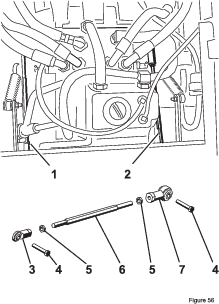
-
Move the motion control lever forward and reverse, then back to neutral. The wheel must stop turning or slightly creep in reverse.
-
Move the throttle lever to the Fast position. Make sure that the wheel remains stopped or slightly creeps in reverse; adjust it if necessary.
-
Repeat steps 6 through 8 for the other side of the machine.
-
Tighten the jam nuts at the ball joints (Figure 65).
-
Move the throttle lever to the Slow position and stop the engine.
-
Remove the jumper wire from the wire harness connector and plug the connector into the seat switch.
Warning
Electrical system will not perform proper safety shut off with jumper wire installed.
-
Remove jumper wire from wire harness connector and plug connector into seat switch when adjustment is completed.
-
Never operate this unit with jumper installed and seat switch bypassed.
-
-
Lower the seat into position.
-
Remove the jack stands.
Adjusting the Maximum Ground Speed
-
Disengage the PTO, move the motion control levers to the neutral locked position, and set the parking brake.
-
Move the throttle lever to the Slow position, stop the engine, remove the key, and wait for all moving parts to stop before leaving the operating position.
-
Remove the bolts securing the front panel and remove the panel (Figure 68).

-
Loosen the jam nut on the stop bolt for one of the control levers (Figure 69).
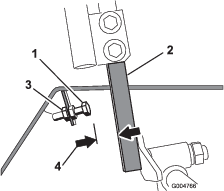
-
Thread the stop bolt all the way in (away from the control lever).
-
Push the control lever all the way forward until it stops and hold it there.
-
Thread the stop bolt out (toward the control lever) until there is a gap of 1.5 mm (0.060 inch) between the head of the stop bolt and the control lever.
-
Tighten the jam nut to secure the stop bolt in place.
-
Repeat steps 4 through 8 for the other control lever.
-
Install the front panel.
Note: If you wish to reduce the maximum machine speed, set the speed for both control levers as directed above, then back each stop bolt out an equal amount toward the control lever until you reach the maximum speed you desire (you will likely have to test your adjustment several times). Ensure that the machine drives straight and does not turn when both control levers are pushed all the way forward. If the machine turns, you do not have the stop bolts evenly set and will need to adjust them further.
Adjusting the Tracking
-
Disengage the PTO, move the motion control levers to the neutral locked position and set the parking brake.
-
Move the throttle lever to the Slow position, stop the engine, remove the key, and wait for all moving parts to stop before leaving the operating position.
-
Loosen the bolts securing the control levers (Figure 70)
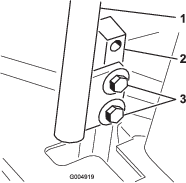
-
Have someone push the control-lever posts (not the control levers) all the way forward into the maximum speed position and hold them there.
-
Adjust the control levers so that they line up (Figure 71) and tighten the bolts, securing the levers to the posts.

Hydraulic System Maintenance
The reservoir is filled at the factory with approximately 4.7 liters (5 quarts) of high quality tractor transmission/hydraulic fluid. The recommended replacement fluid is as follows:
| Toro Premium Transmission/Hydraulic Tractor Fluid (Available in 5 gallon pails or 55 gallon drums. See parts catalog or Toro distributor for part numbers.) |
Alternate fluids: If the Toro fluid is not available, Mobil® 424 hydraulic fluid may be used.
Note: Toro will not assume responsibility for damage caused by improper substitutions.
Note: Many hydraulic fluids are almost colorless, making it difficult to spot leaks. A red dye additive for the hydraulic system oil is available in 20 ml (2/3 oz) bottles. One bottle is sufficient for 15-22 liters (4-6 gallons) of hydraulic oil. Order part number 44-2500 from your Authorized Toro Distributor.
Checking the Hydraulic System
| Maintenance Service Interval | Maintenance Procedure |
|---|---|
| Before each use or daily |
|
Check the level of the hydraulic fluid before the engine is first started and daily thereafter.
-
Position the machine on a level surface.
-
Place the controls in the neutral locked position and start the engine.
Note: Run engine at lowest possible RPM to purge the system of air. Do not engage the PTO.
-
Raise the deck to extend lift cylinders, stop the engine, and remove the key.
-
Raise the seat to access the hydraulic fluid tank.
-
Remove the hydraulic fill cap (Figure 72) from the filler neck.

-
Remove the dipstick and wipe it with a clean rag (Figure 72).
-
Place the dipstick into the filler neck; then remove it and check level of fluid (Figure 72).
Note: If level is not within notched area of the dipstick, add enough high quality hydraulic fluid to raise level to within the notched area. Do not overfill.
-
Replace the dipstick and thread the fill cap finger-tight onto filler neck.
-
Check all hoses and fittings for leaks.
Changing the Hydraulic Oil And Filter
| Maintenance Service Interval | Maintenance Procedure |
|---|---|
| After the first 200 hours |
|
| Every 800 hours |
|
-
Disengage the PTO, move the motion control levers to the neutral locked position, and set the parking brake.
-
Move the throttle lever to the Slow position, stop the engine, remove the key, and wait for all moving parts to stop before leaving the operating position.
-
Place a large pan under the hydraulic reservoir and transmission case and remove the plugs, draining all of the hydraulic fluid (Figure 73).
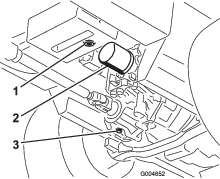
-
Clean the area around the hydraulic oil filter and remove it (Figure 73).
-
Immediately install a new hydraulic oil filter.
-
Install the hydraulic reservoir and transmission case drain plugs.
-
Fill the reservoir to the proper level (approximately 6 quarts); refer to Checking the Hydraulic System.
-
Start the engine and check for oil leaks. Allow the engine to run for about five minutes, then shut it off.
-
After 2 minutes, check the level of the hydraulic fluid; refer to Checking the Hydraulic System.
Storage
Machine
-
Thoroughly clean the machine, deck and the engine, paying special attention to these areas:
-
Radiator and radiator screen
-
Underneath the deck
-
Under the deck belt covers
-
Counterbalance springs
-
PTO shaft assembly
-
All grease fittings and pivot points
-
Remove the control panel and clean out inside of the control box
-
Beneath the seat plate and top of the transmission
-
-
Check and adjust front and rear tractor tire pressure.
-
Check all fasteners for looseness and tighten them as necessary. Especially torque the 6 bolts securing the mower deck frame to the traction unit (Figure 74) to 359 N-m (265 ft-lb).

-
Grease or oil all grease fittings, pivot points, and transmission by-pass valve pins. Wipe off any excess lubricant.
-
Lightly sand and use touch up paint on painted areas that are scratched, chipped or rusted. Repair any dents in the metal body.
-
Service the battery and cables as follows:
-
Remove the battery terminals from the battery posts.
-
Clean the battery, terminals, and posts with a wire brush and baking soda solution.
-
Coat the cable terminals and battery posts with Grafo 112X skin-over grease (Toro Part No. 505-47) or petroleum jelly to prevent corrosion.
-
Slowly recharge the battery for 24 hours every 60 days to prevent lead sulfation of the battery.
-
Engine
-
Drain the engine oil from the oil pan and replace the drain plug.
-
Replace the oil filter.
-
Fill the engine with the recommended motor oil.
-
Start the engine and run it at idle speed for 2 minutes.
-
Drain the fuel from the fuel tank, fuel lines, pump, filter, and separator. Flush the fuel tank with clean diesel fuel and connect all fuel lines.
-
Thoroughly clean and service the air cleaner assembly.
-
Seal the air cleaner inlet and the exhaust outlet with weather proof masking tape.
-
Check the oil filler cap and fuel tank cap to ensure that they are securely in place.